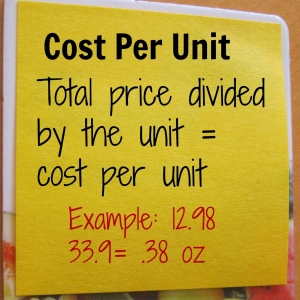If you think “I’ll never be able to save at the grocery store,” consider this: You may have to plan a bit, look over the flyer or even write a list. It doesn’t really matter. Each trip requires you to yield. Yes, yield. If you want to save money on food, here’s how to nail it.
1. Slow down as you approach the aisle.
Take your time while shopping especially if you are looking to spend a certain amount of money on groceries. Sometimes there may be a special promotion on a new variety of your favorite brand (i.e., Multi-Grain Cheerios). If you don’t read the sign carefully, you may pick up an item you are in the habit of buying thinking that the sign pertains to all items under that brand. If you look quickly and grab what you think is on sale, you could end up throwing your budget off course. Take time to read the sign before selecting the item.
2. Prepare to Come to a Full Stop
Sometimes the signs in the grocery store are straightforward. “Buy one, get one free” is pretty easy to figure out. People will tell you to check the cost per unit to get the best value. It’s normally in the lower left hand corner of the sticker. At times, it is not listed. If that’s the case, calculate the cost per unit by dividing the total price by the number of units (ounces, pounds, etc.)
When comparing prices, make sure you are comparing ounces to ounces or pounds to pounds. Now, this sounds simple while you are reading it here, but why does the algorithm leave your memory when you are actually at the grocery store? When you feel rushed because your groceries are melting, someone is standing in your way or your kids are distracting you while shopping, I suggest bringing a cheat sheet. Tape it to your rewards card or write it in your notepad on your phone. So whether you do the math in your head (which I don’t recommend doing with children) or on the calculator, you will have your card as a reference. You can always use an iphone app called Best Value to figure out the better deal too.
3. Check Traffic Conditions Before Proceeding
Sometimes while shopping you come across items that are not on your list that are either priced incredibly low or you just have to have. I think it’s fun to be spontaneous at the grocery store within reason. Build some wiggle room into your grocery budget so you can go off the beaten path once in awhile. If you truly find a good deal that you were not anticipating and you know you will use, then plan for the unexpected. Pick a dollar amount in advance of what I call “in the mood food purchases.” So if the hummus with kalamata olives costs a little more, I know I am still staying within a spending limit and as long as I have the bulk of my everyday groceries purchased, I can treat my family to new and exciting food items.
4. It’s Clear to Go. . .Home
Once you get home and put all of your groceries away, use the Receipt Reference Technique. Put your receipt on the fridge to keep track of what you eat. Mark off items that you used. Refer to it as an informal inventory. Try your best not to waste any of the items purchased. This way you won’t throw any of the savings in the garbage can.

